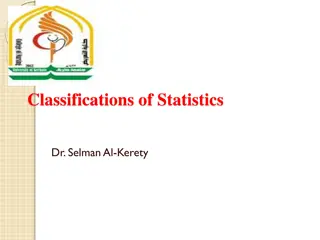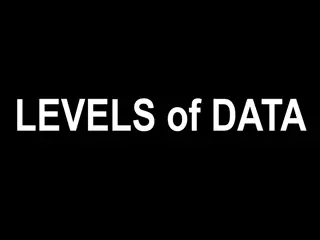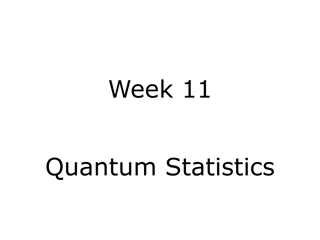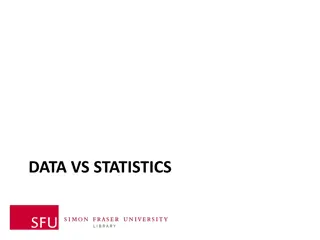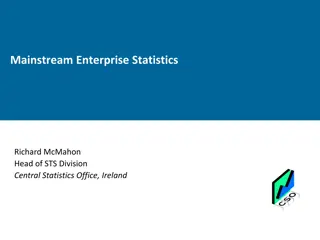Types of Data in Statistics
Data in statistics consists of facts and figures used for analysis. There are primary and secondary data, qualitative and quantitative data, discrete and continuous data, each with distinct characteristics and uses in research methodology.
Download Presentation

Please find below an Image/Link to download the presentation.
The content on the website is provided AS IS for your information and personal use only. It may not be sold, licensed, or shared on other websites without obtaining consent from the author.If you encounter any issues during the download, it is possible that the publisher has removed the file from their server.
You are allowed to download the files provided on this website for personal or commercial use, subject to the condition that they are used lawfully. All files are the property of their respective owners.
The content on the website is provided AS IS for your information and personal use only. It may not be sold, licensed, or shared on other websites without obtaining consent from the author.
E N D
Presentation Transcript
Data In statistics, data is defined as the facts and figures collected together for the purpose of analysis Data are individual pieces of factual information recorded and used for the purpose of analysis. It is the raw information from which statistics are created. Statistics are the results of data analysis - its interpretation and presentation
Types of data Types of data PRIMARY SECONDARY CATEGORICAL(QUALITATIVE) NUMERICAL(QUANTITATIVE)
BASIS FOR COMPARISON Meaning PRIMARY DATA SECONDARY DATA Primary data refers to the first hand data gathered by the researcher himself. Secondary data means data collected by someone else earlier. Data Process Source Real time data Very involved Surveys, observations, experiments, questionnaire, personal interview, etc. Past data Quick and easy Government publications, websites, books, journal articles, internal records etc. Cost effectiveness Collection time Specific Expensive Long Always specific to the researcher's needs. Economical Short May or may not be specific to the researcher's need. Available in Accuracy and Reliability Crude form More Refined form Relatively less
QUALITATIVE DATA QUANTITATIVE DATA BASIS FOR COMPARISON Meaning Qualitative data is the data in which the classification of objects is based on attributes and properties. Quantitative Data is the type of data which can be measured and expressed numerically. Research Methodology Exploratory Conclusive Approach Subjective Objective Analysis Non-Statistical Statistical Collection of data Unstructured Structured Determines Depth of understanding Level of occurrence Asks Why? How many or How much? Sample Small number of non-representative samples Large number of representative samples Outcome Develops initial understanding. Recommends final course of action.
TYPES OF QUANTITAIVE DATA TYPES OF QUANTITAIVE DATA DISCRETE CONTINUOUS
BASIS FOR COMPARISON DISCRETE DATA CONTINUOUS DATA Meaning Discrete data is one that has clear spaces between values. Continuous data is one that falls on a continuous sequence. Nature Countable Measurable Values It can take only distinct or separate values. It can take any value in some interval. Graphical Representation Bar Graph Histogram Tabulation is known as Ungrouped frequency distribution. Grouped frequency distribution. Classification Mutually Inclusive Mutually Exclusive Function graph Shows isolated points Shows connected points Example Days of the week Market price of a product
Examples of continuous data: The amount of time required to complete a project. The height of children. The amount of time it takes to sell shoes. The amount of rain, in inches, that falls in a storm. The square footage of a two-bedroom house. The weight of a truck. The speed of cars. Time to wake up.
Examples of discrete data: The number of students in a class. The number of workers in a company. The number of parts damaged during transportation. Shoe sizes. Number of languages an individual speaks. The number of home runs in a baseball game. The number of test questions you answered correctly. Instruments in a shelf. The number of siblings a randomly selected individual has
MEASUREMENT SCALE MEASUREMENT SCALE NOMINAL ORDINAL INTERVERL RATIO
Nominal: Nominal is from the Latin nomalis, which means pertaining to names . It s another name for a category. Examples: Gender: Male, Female, Other. Hair Color: Brown, Black, Blonde, Red, Other. Type of living accommodation: House, Apartment, Trailer, Other. Genotype: Bb, bb, BB, bB. Religious preference: Buddhist, Mormon, Muslim, Jewish, Christian, Other.
Ordinal: means in order. Includes First, second and. The ordinal scale classifies according to rank. Examples: High school class ranking: 1st, 9th, 87th Socioeconomic status: poor, middle class, rich. The Likert Scale: strongly disagree, disagree, neutral, agree, strongly agree. Level of Agreement: yes, maybe, no. Time of Day: dawn, morning, noon, afternoon, evening, night. Political Orientation: left, center, right.
Interval: has values of equal intervals that mean something. For example, a thermometer might have intervals of ten degrees. Examples: Celsius Temperature. Fahrenheit Temperature. IQ (intelligence scale).
Ratio: exactly the same as the interval scale except that the zero on the scale means: does not exist. For example, a weight of zero doesn t exist; an age of zero doesn t exist. On the other hand, temperature is not a ratio scale, because zero exists (i.e. zero on the Celsius scale is just the freezing point; it doesn t mean that water ceases to exist). Examples: Weight. Height. Sales Figures. Ruler measurements. Income earned in a week. Years of education. Number of children
Scale Types of data Central tendency Absolute zero Statistical test nominal Discrete Mode NO Chi square ordinal Discrete Mode, Median NO Wilcoxson Mann whitney tasr interval continuous Mode, Median, Mean, standard deviation NO T-test ratio continuous Mode, Median, Mean, standard deviation YES Chi square















